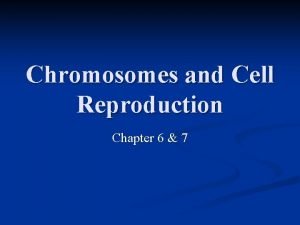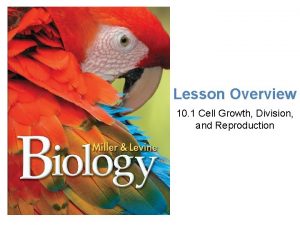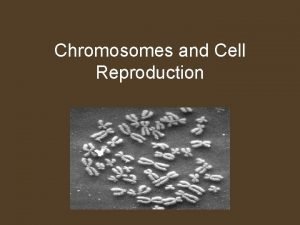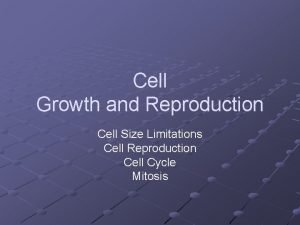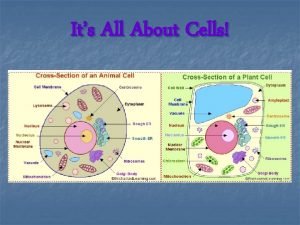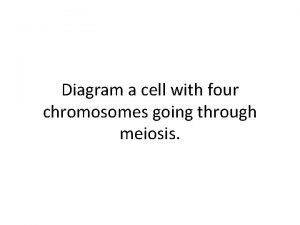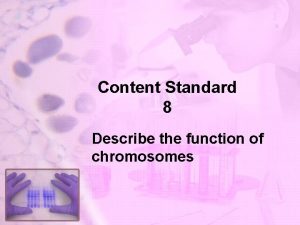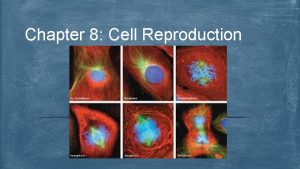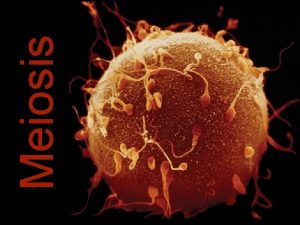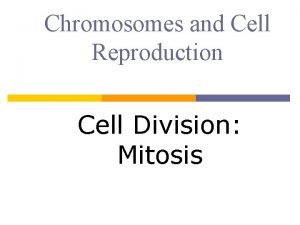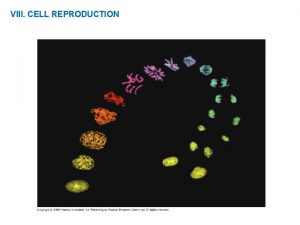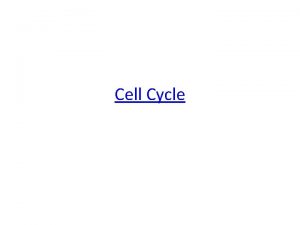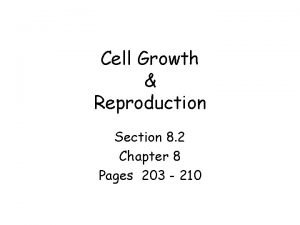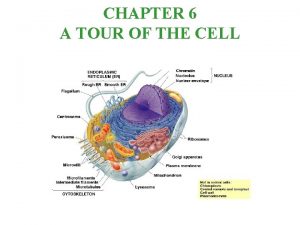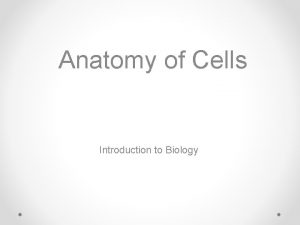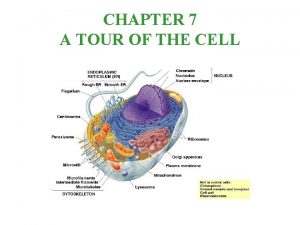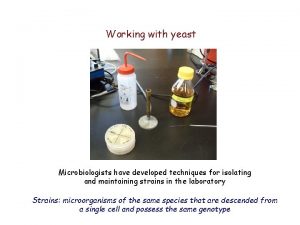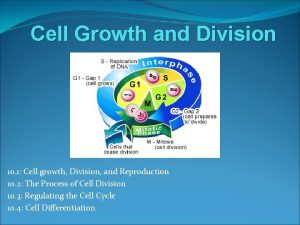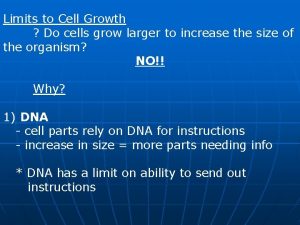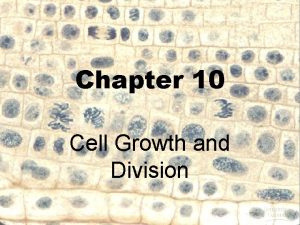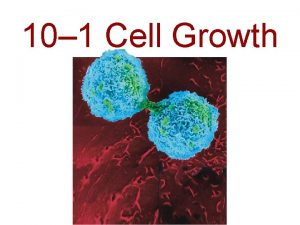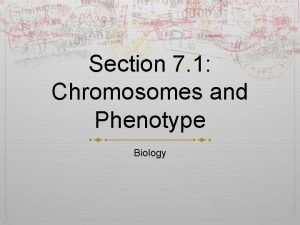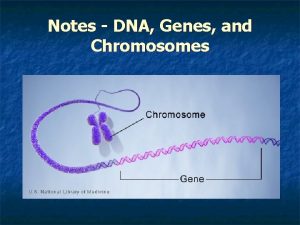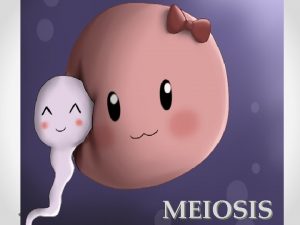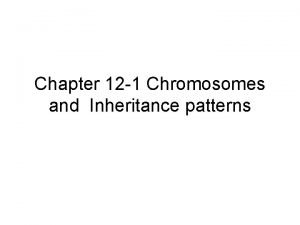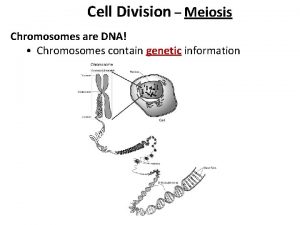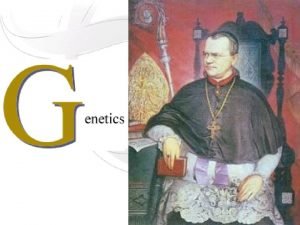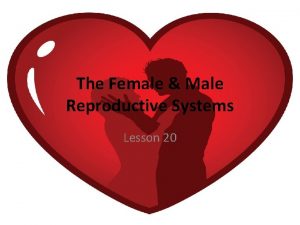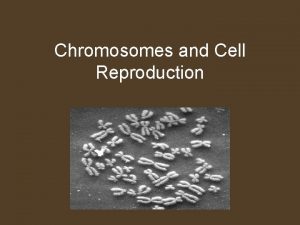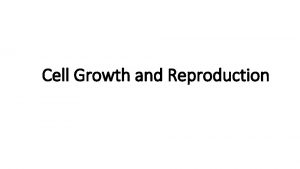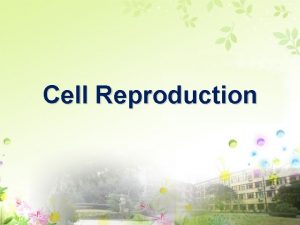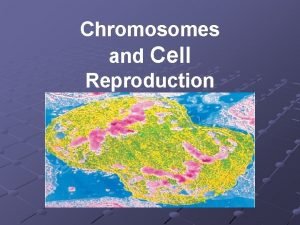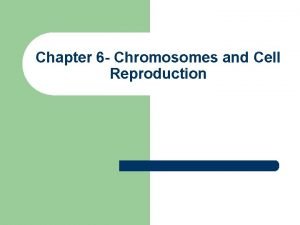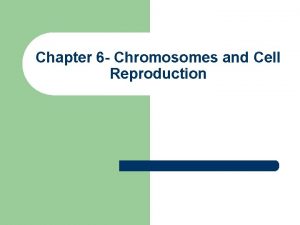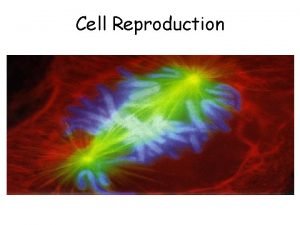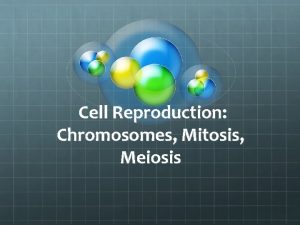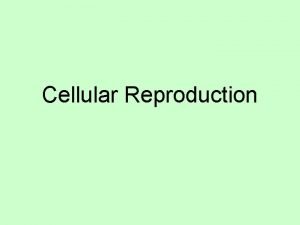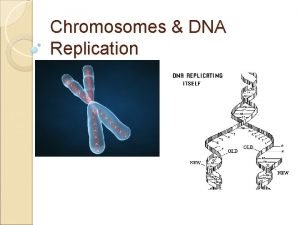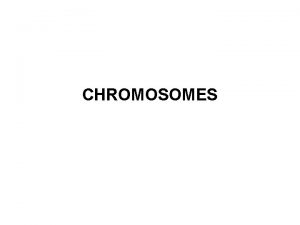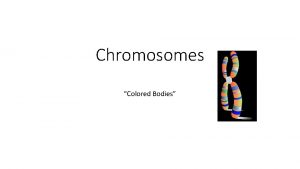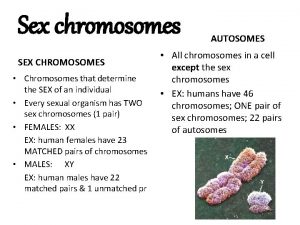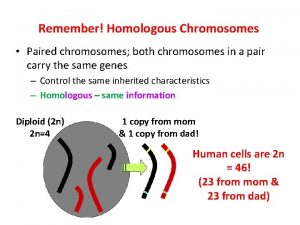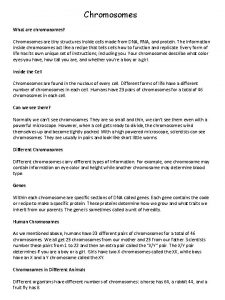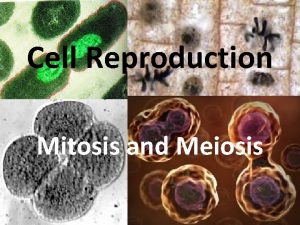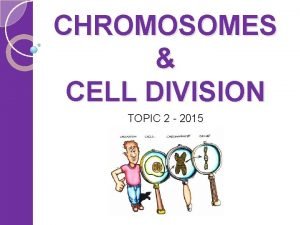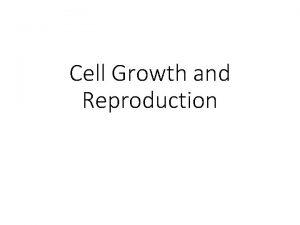Chromosomes and Cell Reproduction Cell Growth Most living













































- Slides: 45

Chromosomes and Cell Reproduction

Cell Growth – Most living cells are between 2 and 20 µm in diameter, but once a cell gets so big it can’t get things in/out like it needs to in order to work properly. – How big a cell can grow is determined by physical factors below: 1. Diffusion rate of materials into and out of the cell. (Remember diffusion only works will over short distance 2. The amount of DNA available to program the cell’s metabolism. 3. The cell’s surface area-to-volume ratio. – So, mitosis is important for cell survival by taking a large cell and dividing it into two identical smaller cells with identical diploid (2 n) genetic material.

Cell Division – Cell division, also called cell reproduction, occurs in humans. 1. Eukaryotic organisms undergoing growth, development, and repair divide their body (somatic) cells by mitosis. 2. Bacteria cells (prokaryotic) undergoing reproduction divide by binary fission since they do not have a nucleus – Binary fission is a form of asexual reproduction that produces identical offspring. – In asexual reproduction, a single parent passes exact copies of all its DNA to its offspring (clones). 3. The formation of gametes involves a third type of cell division. – Gametes, an organism’s reproductive cells, such as sperm or egg cells. – Regardless of the type of cell division that occurs, all of the DNA (deoxyribonucleic acid) must be present in each of the resulting cells.

2 types of cells in eukaryotic organisms Body cells (somatic) – All cells EXCEPT sex cells – Have normal number of chromosomes (diploid) – Examples include: liver, skin, muscle, bone, nerve, leaf, stem, roots, etc Sex cells: (gametes or reproductive cells) – Have half the normal number of chromosomes (haploid) – Made to combine with other sex cells – Examples include: sperm, egg, pollen, etc

Chromosomes: The cell structure in the nucleus that carries the genetic material—DNA. – Chromosomes are the structures that carry MOST genetic information A. Chromosome Structure: A chromosome is a very long DNA molecule that contains many genes. Chromatin- It is the DNA and proteins in the nucleus of a nondividing cell. During most of a cell’s life cycle (interphase) chromosomes exist as chromatin, which are strands of DNA wrapped around protein molecules (uncoiled like tangled-up spaghetti). Chromatin is not visible during this stage. DNA can not be seen under a compound light microscope. DNA can be seen under an electron microscope. Chromatin Chromosome

State Test Question • What structures carry the MOST genetic information for a leaf cell? a) b) c) d) Chromosomes Ribosomes Centrioles Chloroplasts

State Test Question • Which of the structures labeled below contains chromosomes? – – a b c d

Chromosome Structure Cont. Two Parts of the Chromosome: 1. Chromatid- Before the DNA coils up, DNA is copied The chromatin coils up into two identical parts of a chromosome, which are called chromatids. AKA—sister chromatids. 2. Centromere-The point at which each pair of chromatids are attached. Holds chromatid (duplicated chromosomes) together. A chromatid is attached to a spindle fiber by the centromere.

State Test Question a) Chromatin b) Centromere c) Centriole d) Centrosome

Chromosome Numbers: 1. All sexually reproducing organisms have pairs of chromosomes. ** Organisms range in number of chromosomes from 2 to over 300. Ferns have 1, 262 Chromosomes. 2. Homologous Chromosomes: are pairs (2) of chromosomes that are similar in size, shape, and genetic content making up somatic cells -Each homologous chromosome comes from one of the two parents. -Example: The 46 chromosomes in human somatic cells (body cells) are actually 2 sets of 23 chromosomes— 1 set from the mother -1 set from the father. -Example: If one chromosome in a pair contains a gene for eye color, so will the other chromosome in that pair.

Chromosome Numbers: 3. Diploid (2 n): When a cell, such a somatic cell, contains sets of chromosomes, it is said to be diploid. The diploid number in a somatic cell can be written as 2 n=46. **Biologists us the symbol 2 n to represent 2 sets of chromosomes. How many homologous pairs of chromosomes do humans have? __23___ 4. Haploid (n): When a cell, such as a sex cell (gamete), contains one set of chromosomes, it is said to be haploid. n= 1 set of chromosomes The haploid number in a gamete=23 n = 23 (half of 46)

• Fertilization is the joining of gametes (sex cells from opposite sexes. • A zygote is a fertilized egg cell, the first cell of a new individual. Fertilization Zygote

• Zygotes then grow and divide into an embryo through the process of mitosis. • The cell in an embryo go from being stem cells to specific, differentiated cells like heart, lungs, etc. • Stem cells are undifferentiated, unspecific cells that can become any other cell in the body and can be used to replace unhealthy cells

Chromosomes Determine Your Sex: • Of the 23 pairs of chromosomes in human somatic cells, 22 pairs are called autosomes. • Autosomes are chromosomes that are not directly involved in determining the sex (gender) of an individual. • The sex chromosomes, one of the 23 pairs of chromosomes in humans, contain genes that determine the sex of an individual. • In humans, the two sex chromosomes are X and Y chromosomes. • XY chromosomes = male • XX chromosomes = female • Because a female can donate only an X chromosome to her offspring, the sex of an offspring is determined by the male, who can donate either an X or a Y.

The Cell Cycle – – – The life of a eukaryotic cell is the cell cycle which includes interphase, mitosis, and cytokinesis. A cell can only grow so large, when it reaches a certain point it will divide into two cells. So, the cell is as large as it can get—then it divides and the two cells are small. This process is called mitosis. The cell cycle is a repeating sequence of cellular growth and division during the life of an organism. A cell spends 90% of its time in the first three phases of the cycle. What phase does the cell spend the most time? Interphase

State Test Question a) b) c) d) When using a light microscope, which of the following structures is first visible when a cell is dividing? Mitochondrion Ribosome Chromosome Lysosome

State Test Question The ongoing process in which cells grow, develop, and reproduce is called— a) meiosis. b) mitosis. c) the cell cycle. d) interkinesis.

Interphase: • The busiest and longest part of the cell cycle. • The cell is growing and the chromosomes are replicating (copying). • Before mitosis begins, the chromosomes are copied. • Each chromosome now consists of two chromatids. • *Humans have 46 chromosomes (23 pairs), so now 92 chromosomes are ready for cell division. – • 46 will end up in 1 cell, and the other 46 will end up in the 2 nd cell. DNA is the form of chromatin. – Since DNA is the form of chromatin, it is not visible

1. 2. 3. 4. Interphase : G 1 phase— (1 st Gap) Cellular growth & development G 0 Phase- (resting) sometimes this phase is combined with G 1. The cell is resting and is considered dormant/inactive. The cell does not grow, divide or prepare to divide. Cells with extended life spans that do not undergo mitosis stay in G 0 phase and cannot divide (nerve cells, heart muscle cells) S phase— (Synthesis) Cellular growth and DNA synthesis—DNA (chromatin) is replicated/doubled in the nucleus so when the cell divides it has the correct number of chromosomes G 2 phase— (2 nd Gap) Cellular growth and preparation for cell division mitosis by making more organelles and proteins.

State Test Question G 1 Phase, S Phase, and G 2 Phase are all parts of— a) Interphase. b) Anaphase. c) Prophase. d) Teophase.

Mitosis (nuclear division) • Mitosis is the division of all somatic (body cells/non-sex cells). A cut on your hand will repair itself using the process of mitosis. • The first step of mitosis is the chromatin coiling up into chromosomes. • The first three steps are all involved with the splitting of the nucleus • The last step involves the splitting of the cytoplasm, known as cytokinesis. (cytoplasm division, finishes dividing cell) • The end result of mitosis is the formation of two identical daughter cells that are diploid (have a full set of chromosomes [2 n]). • Mitotic cell division: The parent cell divides to form 2 daughter cells with the same number of chromosomes 2 n=46. – • For example: A human cell has 46 chromosomes. How many chromosomes will it have after mitotic cell division? __46_______ Here are the four stages of Mitosis: (PMAT) 1. Prophase 2. Metaphase 3. Anaphase 4. Telophase

State Test Question A frog cell has 26 chromosomes. After the first mitotic division, the cells produced by the zygote will have— a) 52 chromosomes. b) 39 chromosomes. c) 26 chromosomes. d) 13 chromosomes



Prophase (P) a. Stringy chromatin coils up into chromosomes. Chromosomes are most easily seen during this phase because the chromatin shortens and thickens. Each duplicated chromosome is made of the two halves called sister chromatids. Sister chromatids and the DNA they contain are exact copies of each other and are formed when DNA is copied during interphase. b. Nuclear membrane disintegrates (disappears) c. Spindle forms between the pair of centrioles. Spindles are cell structures made up of both centrioles and individual microtubule fibers that are involved in moving chromosomes during cell division. d. Centrioles move to opposite ends (poles) of the cell. Centrioles are cylindrical organelles made of microtubules (proteins) found only in animal cells to help anchor spindles for movement of chromosomes and form the spindle. A pair of centrioles is called a centrosome. The spindles pull the chromosomes to opposite sides of the cell.

Prophase

State Test Question Chromosomes are most easily seen during cell division because the chromosomes-a) double in number. b) shorten and thicken. c) move and expand. d) match up with other chromosomes

State Test Question Which of the following does NOT occur during interphase? a) Chromosomes become visible b) Proteins synthesize c) Chromosomes duplicate d) Proteins translocate

The Cell Cycle Metaphase (M) • Chromosomes line up along the equator. (Centromeres are attached to the spindle fibers. )

State Test Question Which phase of mitosis is represented by the diagram shown above? a) Metaphase b) Prophase c) Telophase d) Interphase

The Cell Cycle Anaphase (A) a. Spindle fibers pull sister chromatids apart at the centromere of the chromosome. b. Chromatids are now called chromosomes. c. Chromosomes move toward opposite poles of the cell.

The Cell Cycle Telephase (T) a) The identical chromatids, now chromosomes, reach opposite poles. b) Nuclear membrane reappears c) Spindles disappear d) Chromosomes uncoil into threadlike pieces DNA is now called chromatin Telophase is the opposite of prophase and you will see two new nuclei forming in the cell

As mitosis ends, cytokinesis begins. Cytokinesis: Divides the cytoplasm and organelles between the two new cells. **New daughter cells will enter into Interphase to begin the cycle over again.

State Test Question • a) b) c) d) Which phase of the cell cycle involves replication of chromosomes? G 1 of interphase The synthesis phase of interphase Prophase Cytokinesis

State Test Question • a) b) c) d) Following telophase, two daughter cells are created when new membranes are formed in the process called— interkinesis. cytokinesis. chromosome replication. crossing over.

State Test Question Lab Notes▪ Chromatids have been separated ▪ The cytoplasm is separating▪ A visible line is forming between sets of chromatids Which phase of mitosis is being described in the lab notes shown above? a) Telophase b) Anaphase c) Metaphase d) Prophase

State Test Question The stages of cell division called prophase, metaphase, and telophase occur during which stage of the cell cycle shown in the diagram below? a) G 1 b) S c) M d) C

State Test Question Which event in mitosis has NOT yet occurred? a) Chromosomes lining up b) Spindle fibers shortening c) Chromosomes duplicating d) Cytoplasm dividing

What are the differences in animal cells and in plant cells undergoing mitosis? 1. Plant cells do NOT have centrioles 2. Plant cells divide their cytoplasm with a cell plate. 3. In animal cells, cytokinesis begins with a cleavage furrow, which pinches the cell into 2 cells. Centrioles

Factors that control the cell cycle: • The cell cycle is carefully controlled. Failure of cellular control can result in cancer. This control is maintained by DNA (genes) giving instructions to make the proper proteins to regulate cell growth and division and signal when it is time to divide. • External signals: – Growth factors, proteins signal the cell to divide, can be produced by cells or released from damaged cells. They may bind to receptors on the surface of cells and signals to the cells to multiply. Some only attach to specific cells. • Internal checkpoints: – Once a cell is stimulated by these external growth factors to divide, internal factors are activated to ensure the cell divides correctly. – Checkpoints: control points in the cell cycle where a stop signal can prevent defects in the cell. If something goes wrong at these checkpoints, the cell cycle will be stopped until conditions become favorable or DNA repairs are made. – Checkpoints are managed by cyclins (special proteins) and kinases (special enzymes) – Apoptosis: programmed cell death when cells become damaged or worn out. It can occur when factors outside or inside the cell signal genes to produce self-destructing enzymes in lysosomes of cells. Ex: embryo hand/foot webbing is removed this way

• G 1 checkpoint: – determines if cell has reached right size and has enough energy and nutrients to proceed through cell cycle. – The cell checks for damage to DNA and ensures the cell is receiving growth factor signals for the cell to divide. • G 2 checkpoint: – prevents the cell from entering mitosis if certain conditions are not met like chromosomes being duplicated correctly • M checkpoint: – aka spindle assembly checkpoint, occurs during mitosis near the end of metaphase, – checks that all sister chromatids are attached correctly to spindle microtubules

• • Cancer is the uncontrolled growth of cells. Cancer is a disorder of cell division and a mistake in the cell cycle. If abnormal cells are not destroyed at the checkpoints, internal growth factors may not be suppressed, and uncontrolled cell growth and division can occur (cancer). Cancer can be caused by aging, stress, viruses, or environmental exposure to carcinogens that damage DNA in cells (tobacco, asbestos, UV radiation, x-rays, some viruses, etc) Carcinogens may cause mutations in genes, permanently changing the DNA sequence. An oncogene is a gene that has the potential to cause cancer if it is expressed. Cancerous cells affect normal cells, forming masses of tissue called tumors. Tumors may be benign (cysts) and not invade other surrounding tissues or malignant and invade other healthy tissues which destroys them. In the final stages, cancer cells enter the circulatory system and spread throughout the body forming new tumors that disrupt the functioning of organs. This is called metastasis. Common cancer treatments include surgery, radiation, and chemotherapy. Chemotherapy and radiation damage healthy cells, while killing cancer cells, causing side effects like low immunity, nausea, vomiting, etc.


State Test Question Which of the following BEST describes the purpose of mitosis? a) The production of a complete copy of the nucleus before cell division b) The division of the cell after the nucleus has been copied c) The production of gametes with half the number of chromosomes of a normal cell d) The replication of DNA within the nucleus

State Test Question Which of the following process is MOST responsible for getting genetic information to each cell in the body of an organism? a) Protein synthesis b) Mitosis c) Diffusion d) Respiration
 Chapter 6 chromosomes and cell reproduction
Chapter 6 chromosomes and cell reproduction Cell growth division and reproduction
Cell growth division and reproduction Hare lynx
Hare lynx Venn diagram of sexual and asexual reproduction
Venn diagram of sexual and asexual reproduction Venn diagram of asexual and sexual
Venn diagram of asexual and sexual Growth and reproduction
Growth and reproduction Growth and reproduction
Growth and reproduction Are prokaryotic cells living or nonliving
Are prokaryotic cells living or nonliving Living and nonliving things venn diagram
Living and nonliving things venn diagram Plant growth definition
Plant growth definition Root hair structure
Root hair structure Primary growth and secondary growth in plants
Primary growth and secondary growth in plants Vascular ray
Vascular ray A cell with four chromosomes going through meiosis
A cell with four chromosomes going through meiosis Function of the chromosome
Function of the chromosome Diploid vs haploid number
Diploid vs haploid number Mitosis meiosis diagram
Mitosis meiosis diagram Is tomato living or nonliving
Is tomato living or nonliving Living non living dead
Living non living dead What is the smallest living unit in all organisms?
What is the smallest living unit in all organisms? Growthchain
Growthchain Geometric growth vs exponential growth
Geometric growth vs exponential growth Neoclassical growth theory vs. endogenous growth theory
Neoclassical growth theory vs. endogenous growth theory Organic vs inorganic growth
Organic vs inorganic growth Cell reproduction
Cell reproduction Mitosis sexual reproduction
Mitosis sexual reproduction Buoflix
Buoflix Cell reproduction
Cell reproduction Section 8-2 cell division
Section 8-2 cell division The cell is a living unit greater than the sum of its parts
The cell is a living unit greater than the sum of its parts A cell is a living unit greater than the sum of its parts
A cell is a living unit greater than the sum of its parts Microfilament function
Microfilament function Nonliving particle that replicates inside a living cell
Nonliving particle that replicates inside a living cell Yeast growth curve
Yeast growth curve 10-1 cell growth
10-1 cell growth Limits to cell growth
Limits to cell growth Section 10-1 cell growth
Section 10-1 cell growth Limits to cell growth
Limits to cell growth Section 1 chromosomes and phenotype
Section 1 chromosomes and phenotype Dna, genes and chromosomes relationship
Dna, genes and chromosomes relationship Metaphase plate
Metaphase plate Meiosis in humans
Meiosis in humans Section 12-1 chromosomes and inheritance
Section 12-1 chromosomes and inheritance Number of chromosomes in meiosis
Number of chromosomes in meiosis Chromosomes and alleles
Chromosomes and alleles Secondary sex character
Secondary sex character
